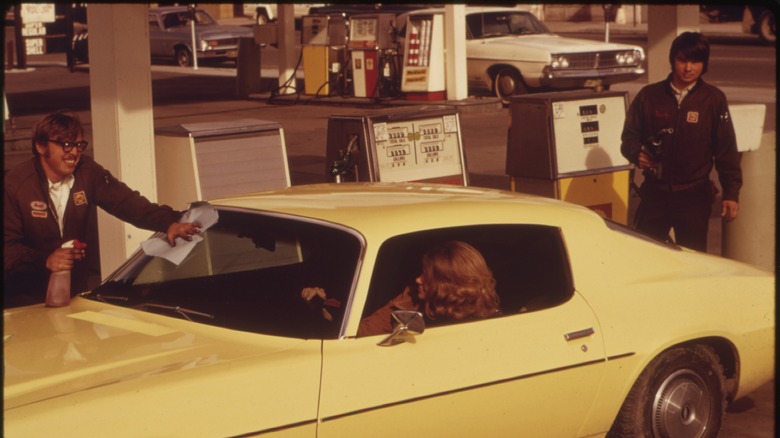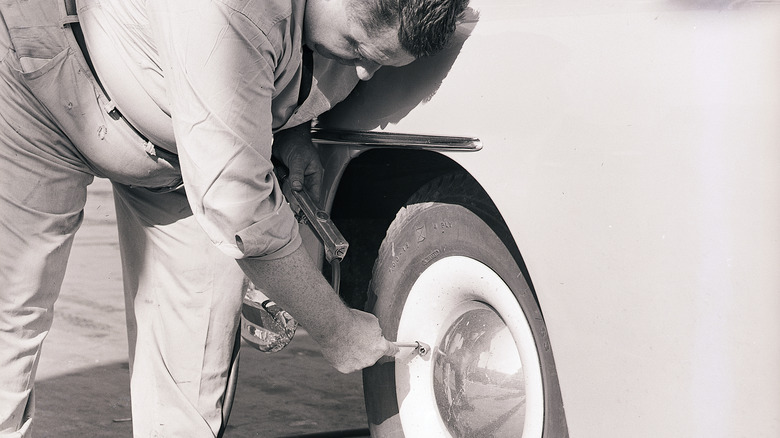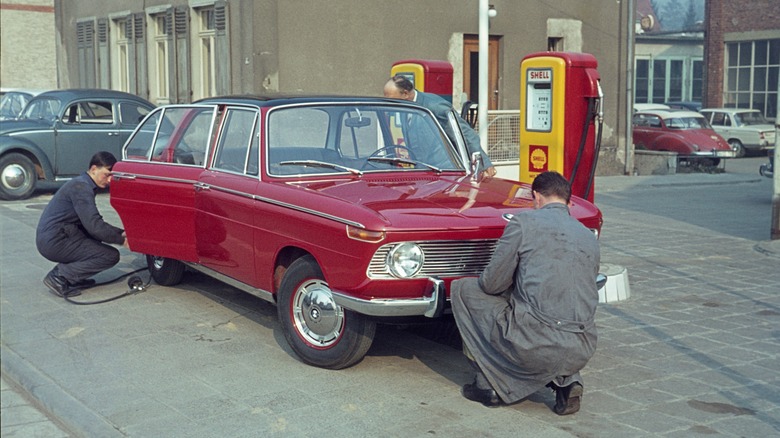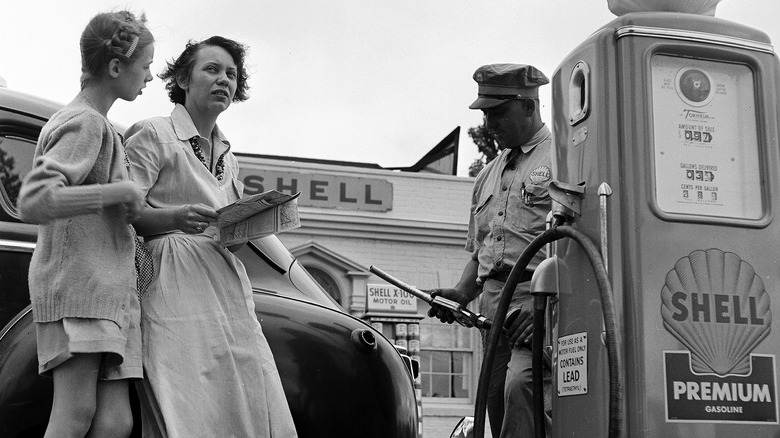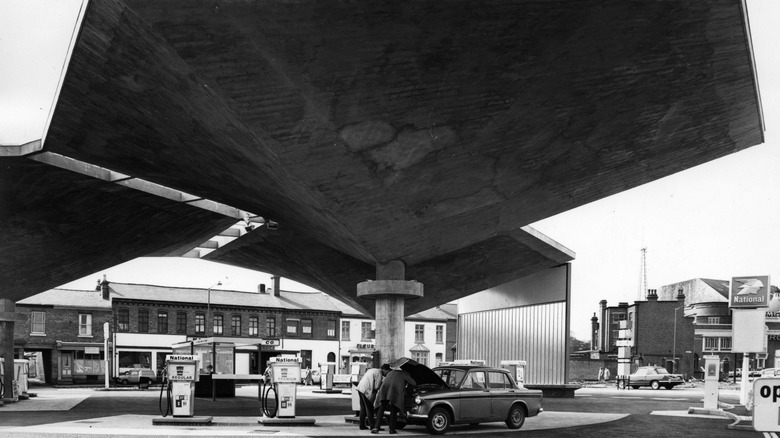5 Reasons Old Gas Stations Were Way Better Than What We Have Now
Everyone knows how modern-day gas stations work. You pull up, get out of your car, pump gas, pay, and leave. You might pick up a cheap, no-frills snack and buy a lottery ticket from the attached office/store. Some will have basic automotive maintenance products such as coolant, wiper blades, etc. — especially useful when you're not as familiar with an area you're passing through or if there simply isn't a fully-fledged auto parts store nearby.
Overall, gas stations are generally very utilitarian spaces, highly functional and impersonal. They are not the kind of place you would ever really want to go to unless you needed fuel and it wasn't too far out of your way.
This was not always the case, though. Go back 50 years, and gas stations used to be significantly different in pretty much every aspect. Yes, they used to pump leaded gasoline, but aside from that, old gas stations had much more to offer than their modern-day counterparts — from the services they offered to even their aesthetic.
Gas stations used to have attendants
You are probably used to a relatively solitary experience at the gas station, where you don't interact with anyone else from when you arrive to when you leave with a full tank. Unless you live in New Jersey or certain parts of Oregon where it's still illegal for customers to pump their own gas or need to go inside to purchase something and thus interact with the cashier, the process is entirely self-service.
This wasn't always the case, though. Gas stations nationwide used to be staffed not just by a cashier inside the main building but also by a crew of attendants who would make the process of getting gas much more convenient. All you had to do was pull up to the pump and tell the attendant which kind of fuel you wanted, and they would take care of the process for you, so you never had to leave the comfort of your vehicle or figure out how a gas pump worked.
Not only did gas station attendants make the process significantly more convenient, but they were also snazzily dressed, wearing distinct uniforms that included bow ties and even hats.
The complementary services
Nowadays, you get what you pay for at gas stations, be it fuel, food, or other supplies. In fact, you become a product at many pumps when they blare their ads at you.
However, back in the '70s, getting gas meant you also got many other services at the same time, all free of charge. While fueling your vehicle up, gas station attendants would offer services such as cleaning your windshield, checking your vehicle's fluids like coolant and oil, and making sure your tires had enough air. While you now have to go elsewhere for these services, not all of them would have been the best for your vehicle. For instance, checking your oil while the engine is running, or has just been turned off, is unlikely to give you an accurate reading. Still, having such easy and free access to those services would have made the experience far more pleasant.
As GPS was decades away from being invented, gas stations were also useful for navigating. You could pick up a free map of the area in case you were from out of town or had simply lost your own.
They could service your vehicle
Old gas stations often functioned as much more than just places to buy gas and cheap snacks. Many of them had full garages, where much more significant auto maintenance and repairs could be carried out beyond the services offered by the attendants at the pump. This would have been much more convenient than the modern-day setup where you must go elsewhere for repairs, especially if you didn't know an area very well. Prior to 1970, if you needed to get your vehicle serviced, all you needed to do was go down to the nearest gas station.
As such, what was then known as "full service" gas stations would offer a very wide range of mechanical services such as tune-ups, replacement of belts and hoses, oil changes, tire changes, and even body work.
Some gas stations even offered breakdown services which would rescue stranded motorists should their vehicles run into major issues on the road. Nowadays, though, instead of gas stations being one-stop-shops for all things automotive, these services have since been phased out and replaced by dedicated businesses, making the whole process of vehicle ownership more complex.
Gas stations used to be social hubs
If you have ever watched the Andy Griffith Show, you might have noticed the number of people meeting at the local gas station staffed by attendant Gomer Pyle. Possibly due to the wider range of services offered or the more personal nature of said services, gas stations used to be a place where many people, old and young alike, would spend a significant amount of time doing things other than fueling up their vehicles. In fact, many places weren't primarily gas stations but rather grocery stores, pharmacies, or even blacksmith shops (though in hindsight, the presence of sparks, furnaces, and fuel may not have been the most advisable mix).
Gas stations were also the place people went to for general information, where kids would get their balls and bike tires inflated, where parents could get lube for the axles on their baby carriages, and more. As prominent businesses, they were also more involved in community development work than they are today.
Gas stations were nicer places to visit
Modern gas stations are usually pretty simple. Rows of pumps under a large rectangular roof and connected store or office suffice in this day and age where we see visiting one as nothing more than a chore that needs to get done.
However, this wasn't always the case. Many gas stations invested in eye-grabbing architecture from a range of styles, depending on which era they were built in. Gas stations were built in Art Deco, Googie, Modernist, and a host of other architectural styles. Some gas stations were also themed, often connected to their brand of fuel. Luckily, some of these unique gas stations still exist, though you may not be able to get fuel at all of them.
Gas station bathrooms were also much more pleasant places than they are today, being regularly cleaned and well-stocked. Even the pumps themselves were more pleasant, as they didn't feature loud and unskippable ads like today's pumps.
